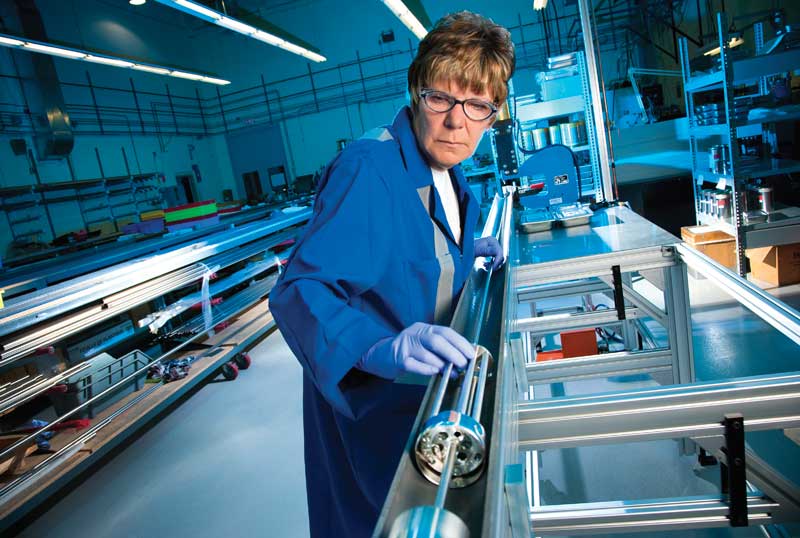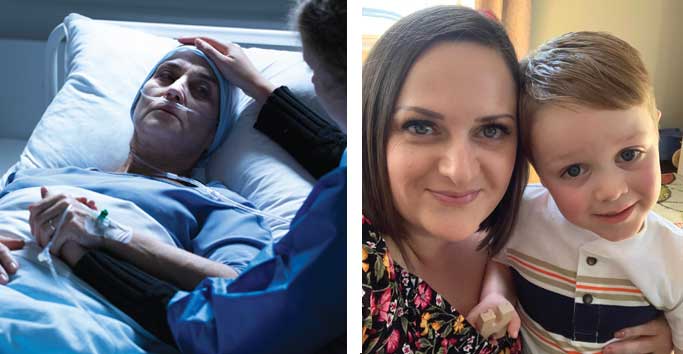
Cameco technician Brenda Sinclair assembles a cobalt adjuster set

Right: Jenny McCaig-Lindsay with her four-year-old son Avery
Isotopes help lead the battle against disease, and Port Hope’s Cameco is a key player.
It may not seem like it some days, but there’s good reason to be optimistic about our lives, despite the falling temperatures, the shrinking daylight hours and the sheltering at home. Bringing hope to often hopeless situations, industries and health-care professionals have joined the battle against everything from cancer to COVID-19, manufacturing and delivering scientific innovations we may never have heard of.
These battles are being waged right here, right now in our region. And one Canadian company, Cameco, is at the vanguard.
WHAT IS AN ISOTOPE?
The radiation from some isotopes is a fundamental tool in medical applications from sterilization of medical equipment to cancer treatment. Briefly, an isotope is an atomic-level variation of a chemical element that is nearly identical to but just slightly different from its base element. For example, carbon-14 – often used to date materials that are very old – is an isotope of basic carbon.
Medical isotopes have yielded treatments and cures that previous generations could only have described as miraculous. Not only are isotopes used successfully to combat the dreaded age-old scourges of heart disease and cancer, they have become formidable weapons in the war on COVID.
ISOTOPES FROM NUCLEAR FUEL
Cameco, a Canadian uranium mining company founded in 1988 and a prominent member of the Cobourg and Port Hope communities, is a vital link in the chain of science and industry leading the worldwide quest for better health. The company’s Port Hope operation processes nuclear fuel that drives the production of 60 per cent of Ontario’s electricity, without emitting carbon. In its Cobourg location, small, non-radioactive pellets of Cobalt-59 are packaged in slim tubes about the size of a pencil, fastened together and shipped to reactors at Bruce Power in Kincardine, Ontario.
What has all this got to do with medicine? The exciting answer is that two years of exposure to radiation in one of the six reactors turns the material into the radioactive isotope Cobalt-60, a literal magic bullet that can be used for multiple medical purposes. The finished product is created and distributed around the world by Nordion, an Ottawabased supplier and exporter of medical products that detect and treat disease, explains Doug Jensen, general manager of Cameco’s fuel-manufacturing operation in Port Hope.
The radiation from Cobalt-60 can penetrate the packaging of medical equipment such as surgical gowns and gloves, catheters, scalpels, bandages and even bodily implants to destroy germs and viruses and prevent contamination and infection, including COVID. Today, it is estimated that 40 to 50 per cent of disposable medical products in developed countries around the world are sterilized using medical isotopes.
“When your dentist or hygienist (or doctor or surgeon) opens a pre-sealed packet, chances are the utensils inside have been sterilized using Cobalt-60,” says Adam McFarland, communications specialist at Cameco.
Of course, sterilization is of utmost importance in hospitals at all times, but global demand has greatly increased during the fight against the current COVID pandemic. Think of all the things we’ve recently become aware of that need sterilization
Economically, culturally and socially, this large Canadian corporation has an unmistakable local footprint. Approaching downtown Port Hope from the north, no one can fail to observe the towering presence of the company’s lakeshore operation. Behind that physical presence, however, is a company with a community-conscious heart.
Cameco works within the community to support everything from the Northumberland Hills Hospital (NHH) and its ongoing operations to the Cameco Capitol Arts Centre, next to the historic Capitol theatre. The list of charities and social services that are beneficiaries of Cameco’s support is long and varied. Suffice to say the company’s arms reach beyond its business into the environmental landscapes, the cultural frameworks and the social safety networks of the region. Particularly relevant at this time, the Cameco COVID Community Relief Fund has contributed $250,000 to 35 different projects.
Cameco’s 250 employees are engineers, scientists, technical experts and skilled tradespeople who work together to manufacture the nuclear materials that result in the isotopes for medical applications, including the fight against cancer and COVID-19. And they are neighbours. Most of the staff have their homes close by, which makes them a major economic and social driver in Cobourg, Port Hope and surrounding areas.
BRINGING THE STORY HOME
Jenny McCaig-Lindsay of Cobourg – a news anchor and reporter for 93.3 myFM, Classic Rock 107.9, and Oldies 100.9 – will never forget the day when, during the height of the Christmas season in 2013, her then-family doctor left a telephone message informing her bluntly that a recent mammogram had revealed she had breast cancer. Jenny would need to begin treatment without delay.
“It’s the worst thing you can hear,” Jenny says. “Things suddenly get very real.”
As a child, she had watched her mother suffer through a radical mastectomy and other painful treatments during a cancer battle that stretched over five long years. Jenny was only eight years old when her mother died in 1990. So, this cancer diagnosis, while not a total bolt from the blue for her, still inflicted a brutal blow.
To her immediate relief, however, Jenny would soon learn that medical science had made tremendous advances in cancer treatments since her mother’s untimely death at age 38.
One of those advances is the use of medical isotopes to precisely locate, target and even destroy tumours.
Today Jenny McCaig-Lindsay is cancer-free, happily married, raising her four-year-old son Avery and singing the praises of Dr. Andrew Stratford, Northumberland Hills Hospital, and medical isotopes.
WHAT IS Tc-99?
Tc-99 is a product of technetium, and is used in surgeries to detect and treat cancer and other diseases at Northumberland Hills Hospital in Cobourg, according to Andrew Rennicks, B.Sc., MRT(n) Charge Technologist in the hospital’s Diagnostic Imaging Department. Most common uses of the isotope include cardiac scanning and treatment of bone, liver, prostate, pancreatic and breast cancers. Naturally occurring technetium, a fission product of uranium and thorium ores or of neutron captures in molybdenum ores, can also be produced in reactors, which depend on nuclear fuel producers like Cameco.
Dr. Andrew Stratford, Chief of Surgical Services at Northumberland Hills Hospital in Cobourg, reassured Jenny that she was not destined to travel the same road as her mother, in part due to the introduction of medical isotopes.
When Jenny came to NHH for her cancer surgery, her breast was injected with the isotope Tc-99, which is used in up to 80 per cent of medical procedures like hers.
The isotope was drawn to the “sentinel node,” that is, the lymph node nearest her tumour. The job of a sentinel is to signal, and that is exactly what it does, playing a vital role in targeting the cancer.
Dr. Stratford compares the lymphatic system around the breast to “a chain.” The injected isotope will follow that chain until it reaches a healthy lymph node, where it stops, thus accurately delineating for the surgeon the size and location of all the affected tissue. The cancerous growth can then be removed through a precisely targeted surgical opening, minimizing both surgical trauma and impact to the healthy surrounding tissue.
If the sentinel node does not indicate signs of further cancer spread, as in Jenny’s case, the surgeon can conclude that the disease has not progressed beyond the breast tissue into the lymphatic system. Detection is the key.
Medical isotopes, which have been in use at NHH since the early 2000s, allow a surgeon more often to perform the less invasive “lumpectomy” rather than a total removal of the breast, or mastectomy – a far more desirable alternative for the patient, both physically and psychologically.
In cancers of all types, the use of medical isotopes increases confidence that the entirety of the affected tissue has been pinpointed and removed and that recovery will be shorter and more complete, with a minimum of pain, convalescence and scarring. If the cancer has not invaded the lymphatic system, Dr. Stratford says, the patient can make the decision whether or not to proceed with radiation or chemotherapy.
A lumpectomy was all that was necessary to give Jenny a clean bill of health. Although her surgery had been successful, Jenny and her consulting oncologist did choose, out of an abundance of caution and in light of her family history, to opt in favour of radiation and chemo treatments. Today she bears minimal scarring, is cancer-free, happily married, raising her four-year-old son and singing the praises of Dr. Stratford, medical isotopes and NHH. For her, the dark days of 2013 are becoming a distant memory.
Contrast Jenny’s experience with those of patients of a hundred or even fifty years ago. Before mammograms and scans came into common use, virtually the only treatment for a lump in the breast was mastectomy. In many cases lymph nodes were removed as well, just in case they happened to be affected. Such surgeries often resulted in lymphedema, severe swelling of the adjacent arm and hand caused by daily accumulation of lymphatic fluid. The whole ordeal was lengthy, painful, disfiguring and distressing. Afterward, despite the extensive attempt at remediation, neither the surgeon nor the patient could be entirely sure that all the cancer had been removed.
Regarding the understandable question of radiological overexposure, Dr. Stratford advises that this is not something that cancer patients treated with medical isotopes need to fear. In fact, Jenny actually received a much lower dose of radiation than if she had been treated with earlier methods. Formerly, diagnosis and treatment required the use of multiple radiological procedures such as CAT scans, PET scans, bone scans, and multiple X-rays, that collectively delivered a much higher dose of radiation than a surgery using medical isotopes.
Most important, Mr. Rennicks, chief of diagnostic imaging at NHH, points out that the Tc-99 isotope remains in the body only long enough to create an image for medical professionals. “Its half-life (time taken to lose half of its radioactivity) is only about six hours.”
Research is always ongoing to expand their uses. Mr. Rennicks explains that isotopes can also be used as a “gamma knife,” where gamma rays from Cobalt-60, rather than a surgical scalpel, are used to precisely locate brain tumours, for example, and destroy them. The benefits of such a treatment, compared to traditional open-skull surgery, are obvious.
“When your dentist or doctor opens a pre-sealed packet, chances are the utensils inside have been sterilized using Cobalt-60.”
Adam Mcfarland, Cameco Communications Specialist
Gamma irradiation, born of Cobalt-60, is a vital component of healthcare manufacturing in more than 40 countries around the world, all of which are engaged in the all-out war against COVID.
Although Jenny was lucky to have her surgery performed close to home, cancer patients all over the region have the option to obtain to similar treatment at larger treatment centres such as Lakeridge in Oshawa or Kingston Health Sciences Centre.
In regional medical centres, isotopes are used to detect and treat cancers but also ailments of the liver, kidneys, thyroid, heart, lungs, gall bladder, stomach, salivary glands, pancreas, bones and prostate.
There are times when all of us are forced to come face to face with adversity. Jenny McCaig-Lindsay’s struggle with cancer is just one such example. She and her family had no choice but to put their trust in the treatments that eventually led to her well-being. She trusted the doctors and the scientists who are at the forefront of progressive innovation – and as luck would have it, those people live in her own backyard.
Story by:
Eileen Argyris
